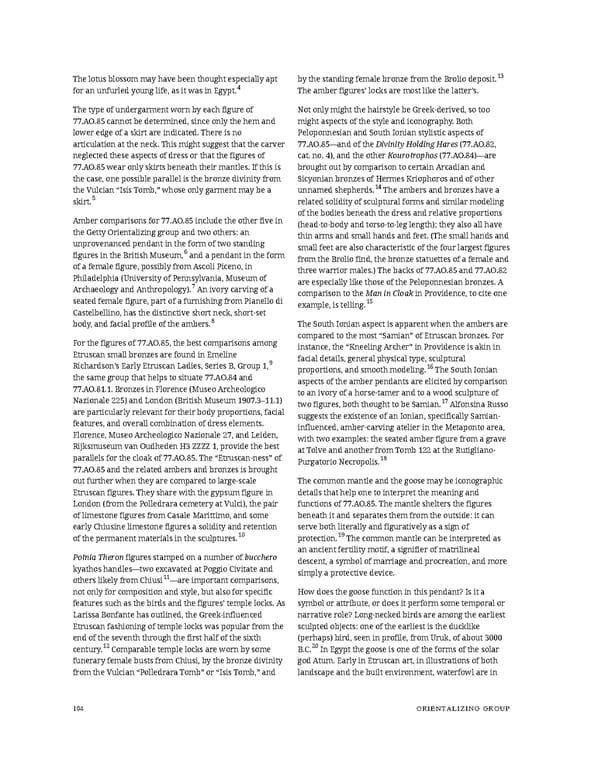The lotus blossom may have been thought especially apt by the standing female bronze from the Brolio deposit.13 for an unfurled young life, as it was in Egypt.4 The amber figures’ locks are most like the latter’s. The type of undergarment worn by each figure of Not only might the hairstyle be Greek-derived, so too 77.AO.85 cannot be determined, since only the hem and might aspects of the style and iconography. Both lower edge of a skirt are indicated. There is no Peloponnesian and South Ionian stylistic aspects of articulation at the neck. This might suggest that the carver 77.AO.85—and of the Divinity Holding Hares (77.AO.82, neglected these aspects of dress or that the figures of cat. no. 4), and the other Kourotrophos (77.AO.84)—are 77.AO.85 wear only skirts beneath their mantles. If this is brought out by comparison to certain Arcadian and the case, one possible parallel is the bronze divinity from Sicyonian bronzes of Hermes Kriophoros and of other the Vulcian “Isis Tomb,” whose only garment may be a unnamed shepherds.14The ambers and bronzes have a skirt.5 related solidity of sculptural forms and similar modeling of the bodies beneath the dress and relative proportions Amber comparisons for 77.AO.85 include the other five in (head-to-body and torso-to-leg length); they also all have the Getty Orientalizing group and two others: an thin arms and small hands and feet. (The small hands and unprovenanced pendant in the form of two standing small feet are also characteristic of the four largest figures figures in the British Museum,6 and a pendant in the form from the Brolio find, the bronze statuettes of a female and of a female figure, possibly from Ascoli Piceno, in three warrior males.) The backs of 77.AO.85 and 77.AO.82 Philadelphia (University of Pennsylvania, Museum of are especially like those of the Peloponnesian bronzes. A Archaeology and Anthropology).7 An ivory carving of a comparison to the Man in Cloak in Providence, to cite one seated female figure, part of a furnishing from Pianello di example, is telling.15 Castelbellino, has the distinctive short neck, short-set body, and facial profile of the ambers.8 The South Ionian aspect is apparent when the ambers are compared to the most “Samian” of Etruscan bronzes. For For the figures of 77.AO.85, the best comparisons among instance, the “Kneeling Archer” in Providence is akin in Etruscan small bronzes are found in Emeline facial details, general physical type, sculptural Richardson’s Early Etruscan Ladies, Series B, Group 1,9 16 proportions, and smooth modeling. The South Ionian the same group that helps to situate 77.AO.84 and aspects of the amber pendants are elicited by comparison 77.AO.81.1. Bronzes in Florence (Museo Archeologico to an ivory of a horse-tamer and to a wood sculpture of Nazionale 225) and London (British Museum 1907.3–11.1) two figures, both thought to be Samian.17 Alfonsina Russo are particularly relevant for their body proportions, facial suggests the existence of an Ionian, specifically Samian- features, and overall combination of dress elements. influenced, amber-carving atelier in the Metaponto area, Florence, Museo Archeologico Nazionale 27, and Leiden, with two examples: the seated amber figure from a grave Rijksmuseum van Oudheden H3 ZZZZ 1, provide the best at Tolve and another from Tomb 122 at the Rutigliano- parallels for the cloak of 77.AO.85. The “Etruscan-ness” of Purgatorio Necropolis.18 77.AO.85 and the related ambers and bronzes is brought out further when they are compared to large-scale The common mantle and the goose may be iconographic Etruscan figures. They share with the gypsum figure in details that help one to interpret the meaning and London (from the Polledrara cemetery at Vulci), the pair functions of 77.AO.85. The mantle shelters the figures of limestone figures from Casale Marittimo, and some beneath it and separates them from the outside: it can early Chiusine limestone figures a solidity and retention serve both literally and figuratively as a sign of of the permanent materials in the sculptures.10 protection.19 The common mantle can be interpreted as an ancient fertility motif, a signifier of matrilineal Potnia Theron figures stamped on a number of bucchero descent, a symbol of marriage and procreation, and more kyathos handles—two excavated at Poggio Civitate and simply a protective device. others likely from Chiusi11—are important comparisons, not only for composition and style, but also for specific How does the goose function in this pendant? Is it a features such as the birds and the figures’ temple locks. As symbol or attribute, or does it perform some temporal or Larissa Bonfante has outlined, the Greek-influenced narrative role? Long-necked birds are among the earliest Etruscan fashioning of temple locks was popular from the sculpted objects: one of the earliest is the ducklike end of the seventh through the first half of the sixth (perhaps) bird, seen in profile, from Uruk, of about 3000 century.12 Comparable temple locks are worn by some B.C.20 In Egypt the goose is one of the forms of the solar funerary female busts from Chiusi, by the bronze divinity god Atum. Early in Etruscan art, in illustrations of both from the Vulcian “Polledrara Tomb” or “Isis Tomb,” and landscape and the built environment, waterfowl are in 104 ORIENTALIZING GROUP
 Ancient Carved Ambers in the J. Paul Getty Museum Page 113 Page 115
Ancient Carved Ambers in the J. Paul Getty Museum Page 113 Page 115